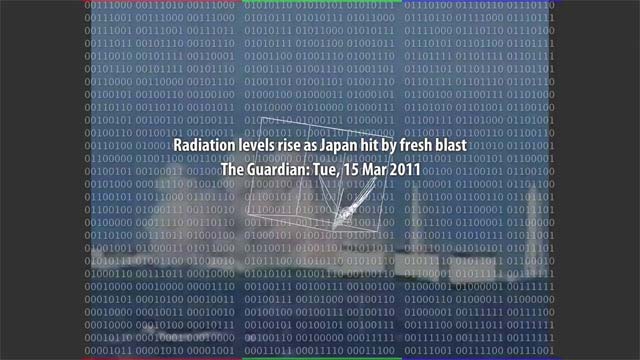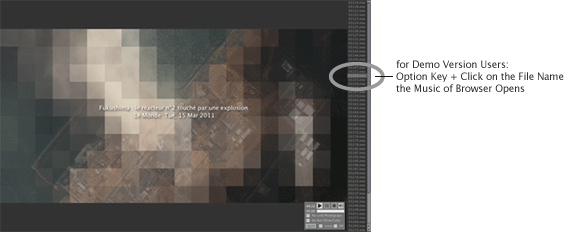Show English: Composition FUKUSHIMA 2011 by Kenji Kojima
Composition FUKUSHIMA 2011 / Kenji Kojima video version from March 11 to March 31, 2011, 01:03:59
The Fukushima nuclear plants accident has not been stopped. It still has been going to contaminate the ocean and the soil. We do not know when it will be stopped. It was not a natural calamity. We must know our civilization caused the disaster. People all over the world was seeing what happened in Fukushima day by day in the year of 2011. However our memory fade away the tragic impacts easily. We must recall the sensation of our experiences and realize what the FUKUSHIMA accident was repeatedly. This is what an artist can do for the disaster.
"Composition FUKUSHIMA 2011" is an experimentation with the relationships between perception and cognition, technology, music and visual art. The composition consisted 335 musics (default March setting is 66 musics) which were created from RGB color data of news photograph's Fukushima nuclear disaster by algorithm. The musics were selected from the Art Project 2011 "RGB Music News" archives (the project was 1/1/2011 to 12/31/2011) chronologically. The project was what news photographs on the internet as reflects of the social phenomenon brought into this world visually and musically.
The music was not an impression of a photograph of musical variations. It composed a score from an image directly. You may have the same elements of visual and audio senses artistically. The art work plays a music with the original image, the mosaic score, binary data of the score, and coordinates in RGB color space of the notes.
Hide English
日本語を表示: コンポジション FUKUSHIMA 2011 by Kenji Kojima
コンポジション FUKUSHIMA 2011 / 小島健治 2011年3月11日から3月31日までの66曲のビデオ版 1時間03分59秒
福島原発事故の大地・海洋汚染が未だに続いているにも関わらず、薄らいでゆくあの日々の感覚。この作品は、欧米の5つのインターネット新聞サイトから世界に発信された福島原発事故の報道写真を、 時系列に沿って写真の視覚データから創られた音楽と共に再現させ、埋もれつつある記憶を視聴覚から統合して、福島原発事故が何だったのか甦させる試みです。 使われている音楽は、作曲者の心情を表した曲ではなく、インターネット上の新聞に載せられた福島原発事故の報道写真から、直接視覚データをコンピュータ・アルゴリズムで音階に変換して曲としています。 コンポジションは、2011年の小島健治のアートプロジェクト「RGB Music News」 のアーカイブから、福島原発事故に関連する写真を選び出し組曲として構成しました。「RGB Music News」は、 1年間で5016曲の音楽を報道写真から作曲したインターネット・アートプロジェクトで、視覚と聴覚の関連、人の感覚と社会現象やインターネットとの関連等を追求したアート作品です。 コンポジションFUKUSHIMA 2011のオリジナル作品は、作者の小島がプログラムした MacOSアプリケーションです。このビデオはアプリケーションRC02版から2011年3月の66曲を録っています。 アプリケーション本編は2011年3月11日から12月31日までの、原発事故報道写真の視覚データから創った335曲の音楽の演奏と、新聞社のサイトとリンクして映し出す写真、その記事の見出しと日付、 写真のデータから作ったモザイクのカラー楽譜、楽譜をRGBカラースペースの座標に表した立方体、RGBカラーのバイナリーデータのスクロールアップで構成されています。 これは同一のデータをそれぞれ違った知覚表現にして、人間の感覚の根底を探る試みです。「コンポジションFUKUSHIMA 2011」は、2012年7月8月サンパウロで開催される 「FILE (Festival Internacional de Linguagem Eletrônica) Hypersonica」と、ドイツのダルムシュタットのサウンド・メディア コンファレンス「the Global Composition」に選出されました。
Hide Japanese | 日本語を隠す

This video is "Edition 2014", Translation used by Google Translate.
"Composition FUKUSHIMA 2011" was selected in "the Global Composition" Darmstadt, Germany on July, 2012, and to be presented in "FILE Hypersonica" Media Art Festival Sao Paulo, Brazil from July 16th until August 19th, 2012.
ダウンロード: MacOS版プレイヤー RC03
フルスクリーン&クオリティ MacOS版 "Composition FUKUSHIMA 2011" Player RC03
• 2011年3月11日から12月31日までのファイルを演奏します。すべての演奏にはパスワードが必要です。RC03版に日本語ダイアログを追加しました。プログラムを使用する国の法律に触れる場合、写真を表示しないを選んでください。 パスワードを持っていなくても始めの8曲を自動演奏し、その他の曲は右側のファイルリストをオプションキー+クリックで「RGB Music News」のアーカイブがブラウザーのウインドウに開きます。
• サウンドインスタレーションとして展示希望でしたら、詳しい内容を作者小島健治までEメールしてください。
Download: MacOS only. Player RC03
Full screen and fine quality. MacOS desktop application "Composition FUKUSHIMA 2011" Player RC03
• The application plays RGB Music files from 03/11/2011 to 12/31/2011 of FUKUSHIMA Disaster, Nuclear and Energy News. Default setting of the application plays only March musics.
• If you are an exhibition organizer, and interested in showing "Composition FUKUSHIMA 2011" for a sound installation, please send email the exhibition details to index@kenjikojima.com. I will send a temporary password.

Composition FUKUSHIMA 2011 is a part of ART PROJECT 2011 "RGB Music News".
Backgrounds of the Project "RGB Music News"
• We have an enormous amount of data on the internet. Contemporary artists may investigate an analysis of data with new technologies for the experimenting with the relationships between perception and cognition, mathematics, technology, music and visual. It will draw out potentials of cross-categories new art forms.
• Many artists and musicians sensed that colors and sounds have connections between them. Some artists and musicians like Wassily Kandinsky (painter), Alexander Scriabin (composer/pianist) and others stated that they could hear sounds what they saw colors, or they could see colors what they heard sounds. It is called Synesthesia. I am not sure whether it is true or not. However It is very curious.
• Musical graphic notation appeared in the middle of 20th century. The composers used graphical patterns, letters and sometimes paintings for their scores. The players of graphic notations played these musics by their own interpretations. The musics were reflected by accidental player's minds and/or their arbitrary decisions. It was too haphazard. Graphic notation was one of interesting ways for searching relation between images and sounds. I wished I would like to have more certain processes of playing graphic notation (visuals).
• A personal computer has been improved rapidly for the last 20 years. Most of contemporary algorithmic composition composers use a computer. Algorithmic composition makes a music without human intervention. Human intervention is in the systematic planning. The composers were not only who wrote computer programming, but the systematic of theorists created musics since the ancient such as Pythagoras, Ptolemy, Plato, canon composers, dice music composers and others. I would like to say algorithmic composition is not only the recent method of composition and engineering matters.
• Many multimedia artists create visual music works by a computer. But they are combined visual and music by artist's sensibility. It is closer to graphic notation player's way. I needed more logical reason the relation between the visual and the music. It was possible using algorithmic composition methods for the idea of graphic notation.
• We often visit internet news sites. We can see so many information on this earth. Besides we can know them in our room. Even if you are on a foreign language news site, Google translate helps.

Composition FUKUSHIMA 2011 / Kenji Kojima video version from March 11 to March 31, 2011, 01:03:59
The Fukushima nuclear plants accident has not been stopped. It still has been going to contaminate the ocean and the soil. We do not know when it will be stopped. It was not a natural calamity. We must know our civilization caused the disaster. People all over the world was seeing what happened in Fukushima day by day in the year of 2011. However our memory fade away the tragic impacts easily. We must recall the sensation of our experiences and realize what the FUKUSHIMA accident was repeatedly. This is what an artist can do for the disaster.
"Composition FUKUSHIMA 2011" is an experimentation with the relationships between perception and cognition, technology, music and visual art. The composition consisted 335 musics (default March setting is 66 musics) which were created from RGB color data of news photograph's Fukushima nuclear disaster by algorithm. The musics were selected from the Art Project 2011 "RGB Music News" archives (the project was 1/1/2011 to 12/31/2011) chronologically. The project was what news photographs on the internet as reflects of the social phenomenon brought into this world visually and musically.
The music was not an impression of a photograph of musical variations. It composed a score from an image directly. You may have the same elements of visual and audio senses artistically. The art work plays a music with the original image, the mosaic score, binary data of the score, and coordinates in RGB color space of the notes.
Hide English
日本語を表示: コンポジション FUKUSHIMA 2011 by Kenji Kojima
コンポジション FUKUSHIMA 2011 / 小島健治 2011年3月11日から3月31日までの66曲のビデオ版 1時間03分59秒
福島原発事故の大地・海洋汚染が未だに続いているにも関わらず、薄らいでゆくあの日々の感覚。この作品は、欧米の5つのインターネット新聞サイトから世界に発信された福島原発事故の報道写真を、 時系列に沿って写真の視覚データから創られた音楽と共に再現させ、埋もれつつある記憶を視聴覚から統合して、福島原発事故が何だったのか甦させる試みです。 使われている音楽は、作曲者の心情を表した曲ではなく、インターネット上の新聞に載せられた福島原発事故の報道写真から、直接視覚データをコンピュータ・アルゴリズムで音階に変換して曲としています。 コンポジションは、2011年の小島健治のアートプロジェクト「RGB Music News」 のアーカイブから、福島原発事故に関連する写真を選び出し組曲として構成しました。「RGB Music News」は、 1年間で5016曲の音楽を報道写真から作曲したインターネット・アートプロジェクトで、視覚と聴覚の関連、人の感覚と社会現象やインターネットとの関連等を追求したアート作品です。 コンポジションFUKUSHIMA 2011のオリジナル作品は、作者の小島がプログラムした MacOSアプリケーションです。このビデオはアプリケーションRC02版から2011年3月の66曲を録っています。 アプリケーション本編は2011年3月11日から12月31日までの、原発事故報道写真の視覚データから創った335曲の音楽の演奏と、新聞社のサイトとリンクして映し出す写真、その記事の見出しと日付、 写真のデータから作ったモザイクのカラー楽譜、楽譜をRGBカラースペースの座標に表した立方体、RGBカラーのバイナリーデータのスクロールアップで構成されています。 これは同一のデータをそれぞれ違った知覚表現にして、人間の感覚の根底を探る試みです。「コンポジションFUKUSHIMA 2011」は、2012年7月8月サンパウロで開催される 「FILE (Festival Internacional de Linguagem Eletrônica) Hypersonica」と、ドイツのダルムシュタットのサウンド・メディア コンファレンス「the Global Composition」に選出されました。
Hide Japanese | 日本語を隠す

This video is "Edition 2014", Translation used by Google Translate.
"Composition FUKUSHIMA 2011" was selected in "the Global Composition" Darmstadt, Germany on July, 2012, and to be presented in "FILE Hypersonica" Media Art Festival Sao Paulo, Brazil from July 16th until August 19th, 2012.
ダウンロード: MacOS版プレイヤー RC03
フルスクリーン&クオリティ MacOS版 "Composition FUKUSHIMA 2011" Player RC03
• 2011年3月11日から12月31日までのファイルを演奏します。すべての演奏にはパスワードが必要です。RC03版に日本語ダイアログを追加しました。プログラムを使用する国の法律に触れる場合、写真を表示しないを選んでください。 パスワードを持っていなくても始めの8曲を自動演奏し、その他の曲は右側のファイルリストをオプションキー+クリックで「RGB Music News」のアーカイブがブラウザーのウインドウに開きます。
• サウンドインスタレーションとして展示希望でしたら、詳しい内容を作者小島健治までEメールしてください。
Download: MacOS only. Player RC03
Full screen and fine quality. MacOS desktop application "Composition FUKUSHIMA 2011" Player RC03
• The application plays RGB Music files from 03/11/2011 to 12/31/2011 of FUKUSHIMA Disaster, Nuclear and Energy News. Default setting of the application plays only March musics.
• If you are an exhibition organizer, and interested in showing "Composition FUKUSHIMA 2011" for a sound installation, please send email the exhibition details to index@kenjikojima.com. I will send a temporary password.

Composition FUKUSHIMA 2011 is a part of ART PROJECT 2011 "RGB Music News".
Backgrounds of the Project "RGB Music News"
• We have an enormous amount of data on the internet. Contemporary artists may investigate an analysis of data with new technologies for the experimenting with the relationships between perception and cognition, mathematics, technology, music and visual. It will draw out potentials of cross-categories new art forms.
• Many artists and musicians sensed that colors and sounds have connections between them. Some artists and musicians like Wassily Kandinsky (painter), Alexander Scriabin (composer/pianist) and others stated that they could hear sounds what they saw colors, or they could see colors what they heard sounds. It is called Synesthesia. I am not sure whether it is true or not. However It is very curious.
• Musical graphic notation appeared in the middle of 20th century. The composers used graphical patterns, letters and sometimes paintings for their scores. The players of graphic notations played these musics by their own interpretations. The musics were reflected by accidental player's minds and/or their arbitrary decisions. It was too haphazard. Graphic notation was one of interesting ways for searching relation between images and sounds. I wished I would like to have more certain processes of playing graphic notation (visuals).
• A personal computer has been improved rapidly for the last 20 years. Most of contemporary algorithmic composition composers use a computer. Algorithmic composition makes a music without human intervention. Human intervention is in the systematic planning. The composers were not only who wrote computer programming, but the systematic of theorists created musics since the ancient such as Pythagoras, Ptolemy, Plato, canon composers, dice music composers and others. I would like to say algorithmic composition is not only the recent method of composition and engineering matters.
• Many multimedia artists create visual music works by a computer. But they are combined visual and music by artist's sensibility. It is closer to graphic notation player's way. I needed more logical reason the relation between the visual and the music. It was possible using algorithmic composition methods for the idea of graphic notation.
• We often visit internet news sites. We can see so many information on this earth. Besides we can know them in our room. Even if you are on a foreign language news site, Google translate helps.